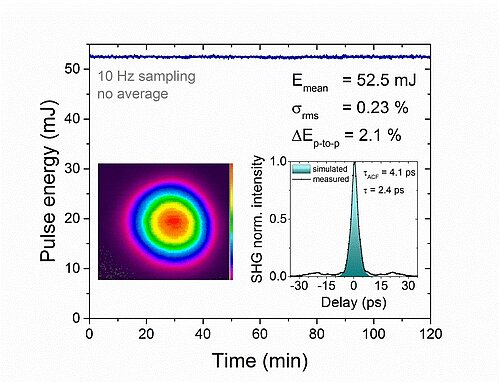Power-scalable ultrafast laser sources in the midwave-infrared (MWIR) are a key element for basic research and applications in material processing and medicine. Optical amplifiers based on chirped pulse amplification (CPA) are used to generate high intensity pulses, a technique awarded with the Nobel Prize in physics in 2018. In the CPA scheme, a weak temporally stretched seed pulse is amplified to high energy in a laser amplifier and finally re-compressed resulting in an ultrashort pulse of very high intensity. Applying this concept a new system was developed at MBI delivering few-ps pulses at 2 µm wavelength with peak power beyond 10 GW (10 billion watt) at a 1 kHz repetition rate. The emitted pulses are characterized by excellent stability and brilliant beam quality. The results are reported in the latest issue of Optics Letters (Optics Letters 45, 3836 (2020)).
The main amplifiers of the 2-µm CPA system are based on Ho:YLF crystals and consist of a highly stable regenerative amplifier and two booster amplifiers. All of them are operated at room temperature and pumped by continuous-wave Tm:fiber lasers with a total power of 270 W. Starting from a 2-µm supercontinuum source the seed pulses are stretched and pre-amplified and subsequently fed into the Ho:YLF amplifier chain. The re-compressed pulse energy of the Ho:YLF CPA amounts to 52.5 mJ and reveals an excellent pulse-to-pulse stability of <0.23% rms. The long-term pulse stability together with the beam quality, measured to be better than a M2 of 1.2, is presented in Fig. 1. The emitted spectrum centered at 2050 nm with a bandwidth of 3.5 nm (FWHM) supports a ~1.7 ps Fourier-transform limited pulse duration. After amplification the pulses are re-compressed in a Treacy-type grating arrangement with an efficiency >93%. The recorded autocorrelation trace exhibits a FWHM of 4.1 ps. This corresponds to a duration of the main pulse of 2.4 ps (FWHM) with an estimated energy content of 85%, translating into 17 GW peak power. The latter and the pulse energy of >50 mJ represent the highest values ever achieved for few-ps pulses at 2 µm wavelength yet.
This source is currently being applied as pump in a system for the generation of few-cycle pulses around 5-µm with multi-millijoule energies. Applications in nonlinear optics, spectroscopy and materials processing are underway.
